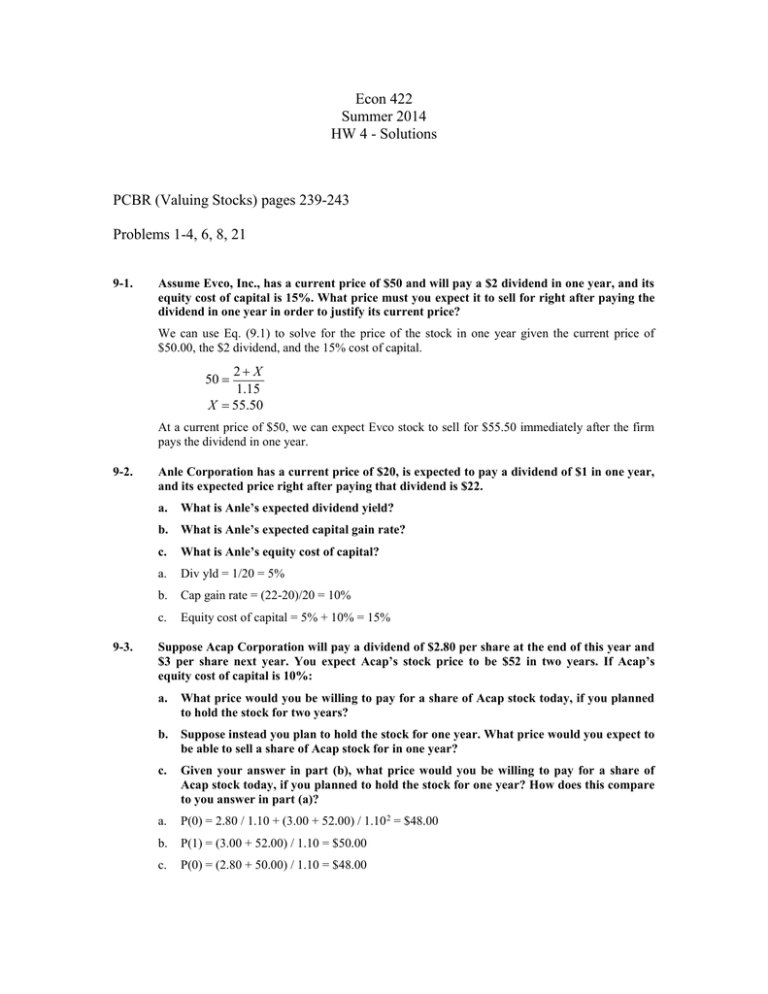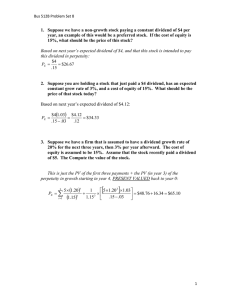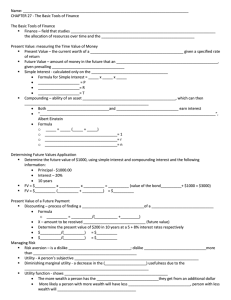File
advertisement

Econ 422
Summer 2014
HW 4 - Solutions
PCBR (Valuing Stocks) pages 239-243
Problems 1-4, 6, 8, 21
9-1.
Assume Evco, Inc., has a current price of $50 and will pay a $2 dividend in one year, and its
equity cost of capital is 15%. What price must you expect it to sell for right after paying the
dividend in one year in order to justify its current price?
We can use Eq. (9.1) to solve for the price of the stock in one year given the current price of
$50.00, the $2 dividend, and the 15% cost of capital.
2 X
1.15
X 55.50
50
At a current price of $50, we can expect Evco stock to sell for $55.50 immediately after the firm
pays the dividend in one year.
9-2.
9-3.
Anle Corporation has a current price of $20, is expected to pay a dividend of $1 in one year,
and its expected price right after paying that dividend is $22.
a.
What is Anle’s expected dividend yield?
b.
What is Anle’s expected capital gain rate?
c.
What is Anle’s equity cost of capital?
a.
Div yld = 1/20 = 5%
b.
Cap gain rate = (22-20)/20 = 10%
c.
Equity cost of capital = 5% + 10% = 15%
Suppose Acap Corporation will pay a dividend of $2.80 per share at the end of this year and
$3 per share next year. You expect Acap’s stock price to be $52 in two years. If Acap’s
equity cost of capital is 10%:
a.
What price would you be willing to pay for a share of Acap stock today, if you planned
to hold the stock for two years?
b.
Suppose instead you plan to hold the stock for one year. What price would you expect to
be able to sell a share of Acap stock for in one year?
c.
Given your answer in part (b), what price would you be willing to pay for a share of
Acap stock today, if you planned to hold the stock for one year? How does this compare
to you answer in part (a)?
a.
P(0) = 2.80 / 1.10 + (3.00 + 52.00) / 1.10 2 = $48.00
b.
P(1) = (3.00 + 52.00) / 1.10 = $50.00
c.
P(0) = (2.80 + 50.00) / 1.10 = $48.00
9-4.
Krell Industries has a share price of $22 today. If Krell is expected to pay a dividend of $0.88
this year, and its stock price is expected to grow to $23.54 at the end of the year, what is
Krell’s dividend yield and equity cost of capital?
Dividend Yield = 0.88 / 22.00 = 4%
Capital gain rate = (23.54 – 22.00) / 22.00 = 7%
Total expected return = rE = 4% + 7% = 11%
9-6.
Summit Systems will pay a dividend of $1.50 this year. If you expect Summit’s dividend to
grow by 6% per year, what is its price per share if its equity cost of capital is 11%?
P = 1.50 / (11% – 6%) = $30
9-8.
Kenneth Cole Productions (KCP), suspended its dividend at the start of 2009. Suppose you
do not expect KCP to resume paying dividends until 2011.You expect KCP’s dividend in
2011 to be $0.40 per year (paid at the end of the year), and you expect it to grow by 5% per
year thereafter. If KCP’s equity cost of capital is 11%, what is the value of a share of KCP at
the start of 2009?
P(2010) = Div(2011)/(r – g) = 0.40/(.11 – .05) = 6.67
P(2009) = 6.67/1.112 = $5.41
Using the Normal Distribution
1. Suppose the returns on long-term government bonds are normally distributed. Based
on the historical record from 1926 – 2004 the annual mean return was estimated to be 5.8
percent and the annual standard deviation was estimated to be 9.3 percent. What is the
approximate probability that the return on bonds will be less than -3.5 percent in any
given year? What range of returns would you expect to see 95 percent of the time? What
range would you expect to see 99 percent of the time?
In the normal probability distribution, approximately 2/3 of the observations are within
one standard deviation of the mean. This means that 1/3 of the observations are outside
one standard deviation away from the mean. Or:
Pr(R< –3.5 or R>15.1) 1/3
But we are only interested in one tail here, that is, returns less than –3.5 percent, so:
Pr(R< –3.5) 1/6
You can use the z-statistic and the cumulative normal distribution table to find the
answer as well. Doing so, we find:
z = (X – µ)/
z = (–3.5% – 5.8)/9.3% = –1.00
Looking at the z-table, this gives a probability of 15.87%, or:
Pr(R< –3.5) .1587 or 15.87%
EXCEL COMPUTATION: Using the NORMDIST function in Excel, we have
Pr(R< –3.5) = NORMDIST(-0.035, 0.058, 0.093, TRUE) = 0.158655
The range of returns you would expect to see 95 percent of the time is the mean plus
or minus 2 standard deviations, or:
95% level: R ± 2 = 5.8% ± 2(9.3%) = –12.80% to 24.40%
The range of returns you would expect to see 99 percent of the time is the mean plus
or minus 3 standard deviations, or:
99% level: R ± 3 = 5.8% ± 3(9.3%) = –22.10% to 33.70%
2. Using probability distributions. Suppose the returns on large-company stocks are
normally distributed. Based on the historical record from 1926 – 2004 the annual mean
return was estimated to be 12.4 percent and the annual standard deviation was estimated
to be 20.3 percent. Determine the probability that in any given year you will lose money
by investing in a diversified portfolio of large company stocks. Hint: use the normdist
function in EXCEL.
Using the z-statistic, we find:
z = (X – µ)/
z = (0% – 12.4)/20.3% = –0.6108
Pr(R≤0) 27.07%
EXCEL COMPUTATION: Using the NORMDIST function in Excel, we have
Pr(R≤0) = NORMDIST(0, 0.124,0.203,TRUE) = 0.270654
Expected Utility Hypothesis Problems
1. A consumer has the utility function u = U(W) = ln(W) where u represents the level of
utility, U(W) represents the general form of a utility function, W is the consumer's
wealth, and ln(W) represents a specific utility function that specifies that the value of the
utility index associated with a given level of wealth, W, is given by the natural log (base
e) of W.
The consumer's wealth is not fixed, but is a random variable given by the probability
distribution:
Possible value of W: 100,000
Probability of W:
0.2
U(W)
11.5129
150,000
0.5
11.9184
200,000
0.2
12.2061
250,000
0.1
12.4292
a. Compute the consumer's expected wealth i.e. E(W).
E(W)=.2(100000)+...+.1(250000)=160000
b. Extend the table to show the possible values of U(W).
See table above
c. Compute the expected utility of wealth, i.e. .E[U(W)]
E[U(W)]=.2(ln(100000))+...+.1(ln(250000))=11.9459165
d. Show that E[U(W)]U(E(W)).
Result in part c is not equal to ln(160000)=11.9829291
e. Find the certainty equivalent wealth, that is the wealth, which if held for certain, would
be regarded as equivalent in the utility sense to the random wealth distribution given
above. i.e. find Wc such that U(Wc)=E[U(W)].
If you had Wc for sure it would be worth ln(Wc). We showed above that the risky wealth
has an expected utility value of 11.9459165. For what value of Wc does ln(Wc) have the
same value.
ln(Wc)=11.9459165. Take the exponential of both sides to get
Wc=exp{11.9459165}=154,186.24.
2. A person's utility of wealth function is U(W)=ln(W), i.e. the person's utility associated
with any given level of wealth is equal to the natural log of the wealth level. If the person
chooses occupation A his or her wealth is given by the following wealth distribution:
Wealth:
Probability:
1,400,000
0.8
2,400,000
0.2
If the person chooses occupation B his or her wealth is given by the following wealth
distribution:
Wealth:
Probability:
1,500,000
0.5
1,700,000
0.5
a. Which occupation will the person choose and why? Or will the person be indifferent to
the alternatives? Explain.
b. Compute the certainty equivalent wealth for occupation B.
Risk-Return Questions
1. The probability distribution for next year’s price of Google stock is given by
Price P1
Probability
$300
0.1
$400
0.2
$500
0.5
a. Compute the expected value and variance of next year’s price.
The expected stock price next year is
E[ P1 ] 300(0.1) 400(0.2) 500(0.5) 600(0.2) 480
$600
0.2
To compute the variance use
V ( P1 ) E[ P12 ] E[ P1 ]2
E[ P12 ] (300) 2 (0.1) (400) 2 (0.2) (500) 2 (0.5) (600) 2 (0.2) 238, 000
V ( P1 ) E[ P12 ] E[ P1 ]2 238, 000 (480) 2 7, 600
b. Compute the expected annual rate of return and standard deviation of the annual rate of
return if the current price is $500 and you do not expect to receive a dividend at time 1.
The annual rate of return is
R
P1 P0 P1
1.
P0
P0
Since P0 = 500 is known, the expected rate of return is
E[ R]
E[ P1 ] P0 E[ P1 ]
480
1
1 0.04
P0
P0
500
The variance and standard deviation of the rate of return are
P 1
7600
V ( R) V 1 2 V ( P1 )
0.0304
(500) 2
P0 P0
SD ( R ) 0.0304 0.1744
PCBR Chapter 15 (Uncertainty) Answer: pages 549 – 551 (back of chapter)
Questions 1,2 4
Problems 16 and 22.






